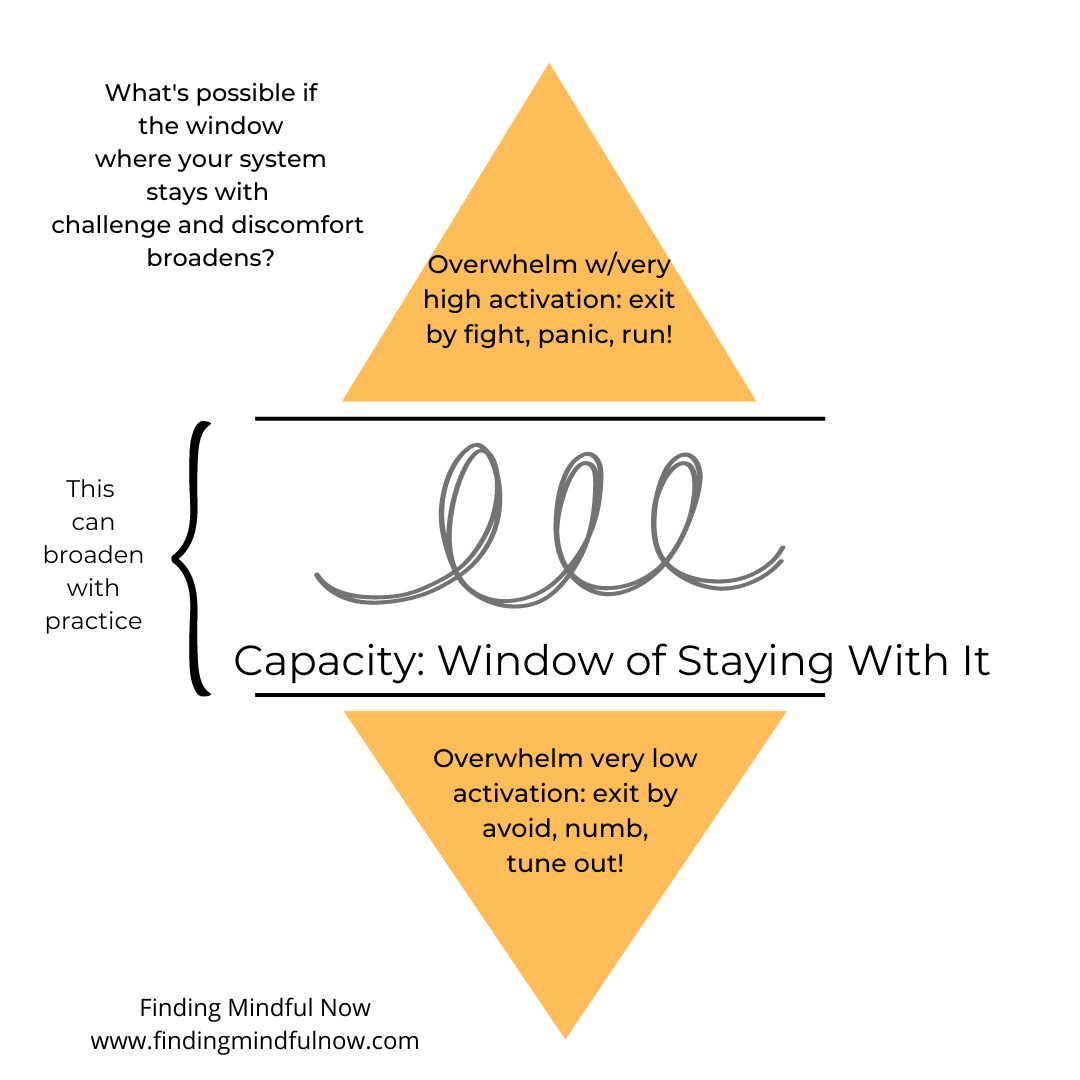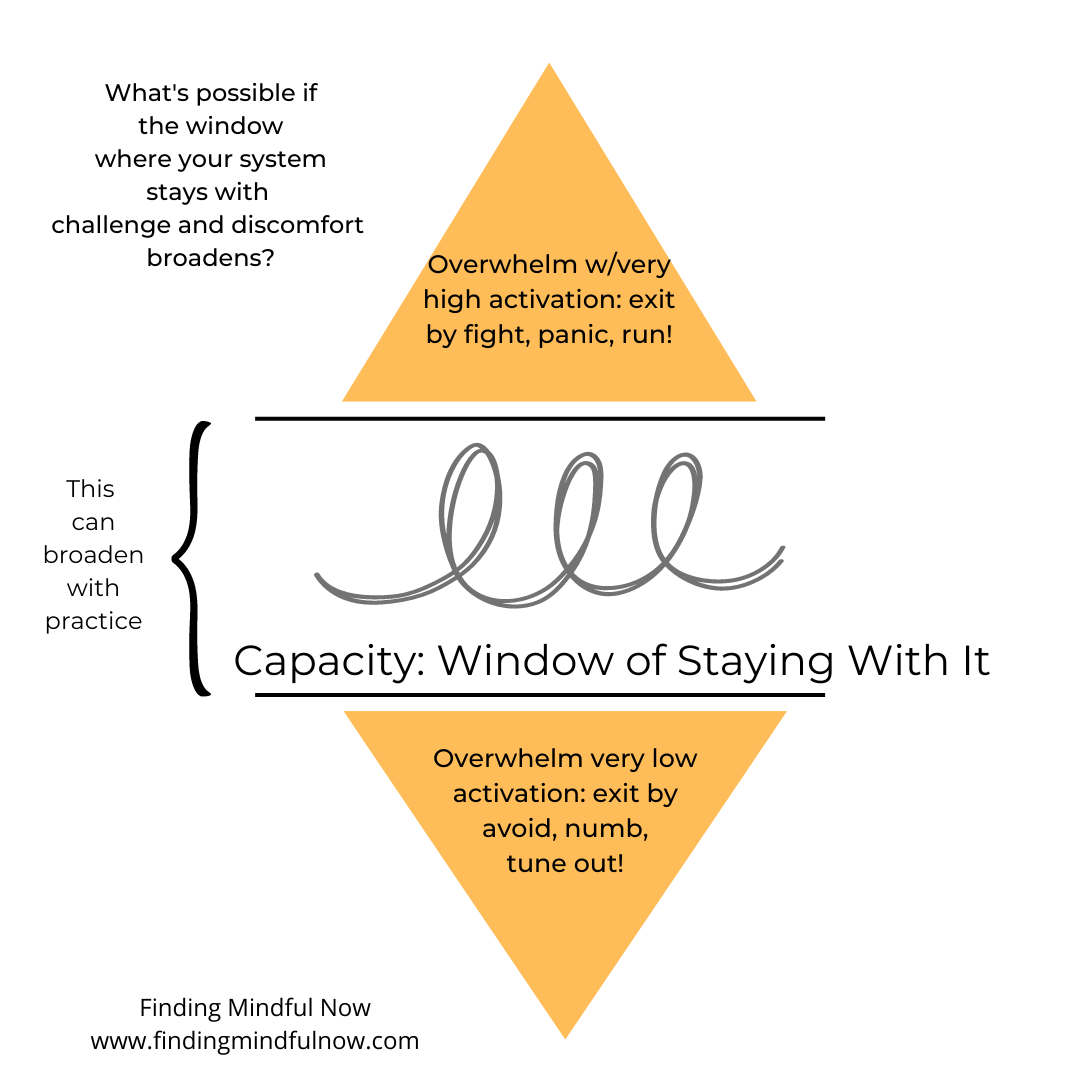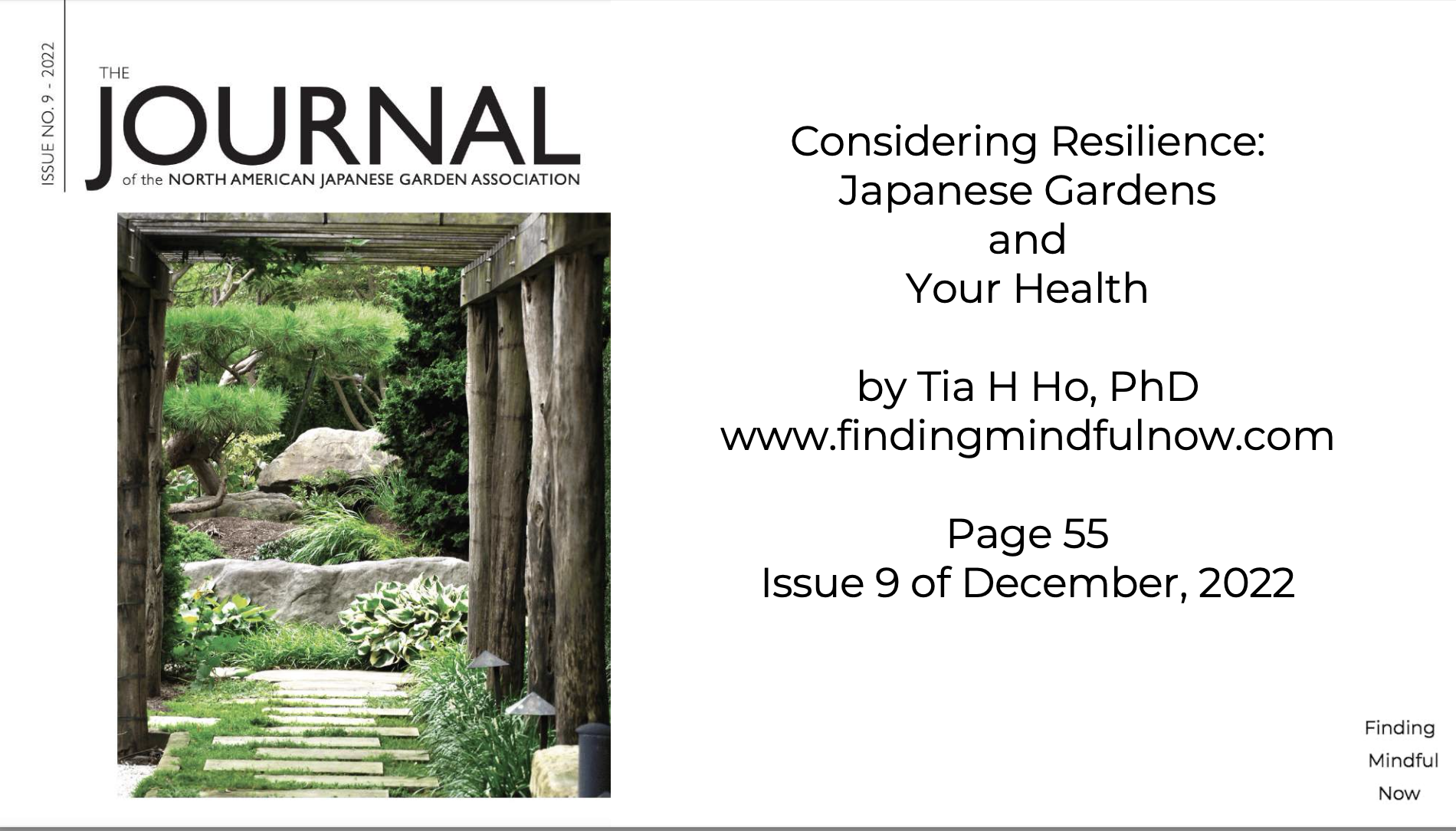Moment of Mind January 2023


Moment of Mind
Welcome all, my heart goes to you if you're in the midst of a hard time right now.
A body-based support I've been using lately is to notice my belly, to breathe into it, then to notice my back, and breathe into it, and to repeat this sequence three times. It helps me to put my hand on my belly when I do that. You're welcome to try it.
*******
The invitation for the month is to notice what supports you use to stay engaged in feeling sensations, being with whatever is happening, when experiencing challenge or discomfort?
In February I'm offering a course at two different days/times called Nourish: Body Awareness. As preparation, this last week I've been posting videos on instagram exploring one of the premises for it. The main point of the course is to inquire into various nervous system supports that, with practice, can help the brain-body system learn to widen the window of staying with challenging sensations.
You might be wondering why we would explore this.
And maybe even why would anyone *want* to stay with challenging feelings or discomfort?
I am finishing the Integrated Somatic Trauma Therapy Certificate program this month through the Embody Lab and found it interesting how frequently the topic of staying with challenging emotions came up. Apparently, the body can't integrate traumatic memories, or prevent current emotionally stressful situations from becoming stored as trauma, when it can't stay with feeling them.
Let me repeat that.
The brain-body will maintain an old memory as an emotional wound, generating suffering, as long as the system cannot stay with feeling those sensations fully. It's also more likely that a challenging situation will be encoded and held onto, if there isn't capacity to stay with feeling it in real time as it's happening.
That saying that gets tossed around, "you have to feel to heal" turns out to be based on actual research.
"Integration," in this context, is about when multiple networks of the brain are able to access and store whatever the situation is, as a regular memory. Traumatic memories are treated differently by brain neural networks than other memories. They aren't accessed in the same way, which is why they can be so difficult to intentionally, skillfully, access and reprocess as part of healing.
"Reprocessing" involves intentionally calling the trauma memory (or core theme of many memories) back into the present and feeling into the sensations that arise with supports that were unavailable at the time the event(s) occurred. Those supports involve feeling into sensations, breathing, orienting to the present moment, and may also include inquiry about what happened, re-storying the meaning of those events, connecting to allies (ancestral, current, past, etc.)...and more. The idea is for the core you to witness, parent, and love the wounded parts. Each person is unique, so each mix of supports will vary based on the person and what the system is doing at the time.
That reprocessing can't happen without the system perceiving relative safety for the body. Bodily sensory resources, including the ones I'll cover in the Nourish: Body Awareness course, are fundamental to supporting that.
Even if you aren't a complex trauma survivor like me, these supports ensure you can stay with challenging stressors.
"Staying with it" is related to what's called the window of tolerance by folks who study emotional intelligence. The window of tolerance, first coined by Dan Siegel, MD, back in 1999 to describe when someone's system stays emotionally regulated and can continue to think clearly and function effectively. One way trauma is defined (instead of a stressor for example) is anything that takes you far out of the window of tolerance where the system can't stay with sensations and integrate them.
Emotional regulation doesn't mean controlled or calm. In fact, what can look like "controlled" can be a form of avoidance. Regulation means that there's natural fluctuations with what the emotions are doing and that the system doesn't go so high or so low in terms of activation that the person can't think or function as effectively.
One foundation to staying within the window is what's called resourcing. Resources are innate supports the system draws on to function. The brain utilizes resources continually - whether it stays in the window of tolerance or not. Some resources we refer to as "coping" and prevent the wound from being integrated by the whole system, while others support the integration.
Many resources are effective at avoiding feeling by going out of the window of tolerance. Scrolling on social media, staying busy, avoiding interactions, exercise, meditation, cleaning the house, alcohol, food, drugs, etc. are all ways the body may avoid feeling. Some of these may have side effects you like, and some may have side effects that aren't as supportive anymore.
Dissociation is an example resource the body uses to go out of the window of staying with it to avoid feeling. This was one of the main resources my system used in childhood, teen years, and my 20s and 30s until numbing and avoidance began creating multiple life problems. I sought out new learning for the system to change that.
Dissociation is a powerful tool for maintaining function when we are in situations where we can't stop what we're doing to be with sensations and the resulting emotional releases. My brain-body system still uses it at times (like when my mom died last year), although there's now awareness when it happens.
Resources aren't right or wrong, they are just what the system has learned from conditioning and *always* have benefits even if our minds may judge them. The main short term benefit for the system is to handle things and save feeling emotions until there's space and supports later.
What we'll cover in the course are resources that support nervous system settling to allow feeling. One of the starting points is the reminder of choice, that you can try on any of them, and choose to discard ones that don't fit you for whatever reason.
Since my offerings may not feel like a fit for you at this time, I'm also sharing a few of my favorite somatic practitioners from the certification who offer supportive somatics for learning resourcing. You can click on the links below to explore.
- Ruby Gibson's ancestral healing master class, indigenous-led
- Lumos Transforms Resilience for Liberation (free, many session are led by BIPOC instructors)
- Nikki Myers combined yoga with the 12 step program to treat various forms of addiction and has a series of free meditations on her website
- Lisa Dion works with children using synergistic play therapy, which had SO much ah-ha moments for me as an adult too
- Staci Haines of Strozzi Institute sharing a centering practice she uses with groups for collective transformation
Much love,
Tia

Nourish: Body Awareness, February 2023
Join me in a month long exploration of body awareness, zooming into how feeling sensations is a foundation for growth (click on the image to go to the course page). Through four zoom calls, homework invitations, and group discussions we'll see what opens up when numbing or resistance gives way to feeling.
If it doesn't fit your schedule now, stay tuned as I'm working on an audio-only version at a lower price point for Insight Timer.
Image of hands clasped below pouring water from mrjn photography of unsplash.
Love for Your Inner Science Activist Nerd
Shifting gears from bodily awareness which may take our senses both inside and notice our environment outside...let's revisit some of the research on health and greenspaces. A study in 2019 co-authored by one of my colleagues revealed that people living 500 meters or closer to a publicly accessible natural space were more likely to report a higher sense of community belonging than those living further away without this access (Rugel et al, 2019). They defined "natural space" as a green space with a permanent water feature (which they call "blue space" not to be confused with a cloudless sky).
The researchers also found that higher levels of sense of community and belonging were associated with higher mental health outcomes. The authors suggest that having publicly accessible nature at the neighborhood level may mediate psychological distress from when people experience social isolation.
The authors emphasized that public access, rather than private access (e.g. a yard), was an important finding because of its implications for public parks and other public natural areas. For example, another study from 2015 found a 42% lower odds of psychological distress among individuals when greenspaces was accessible instead of when it was inaccessible (Pope et al 2015).
What this, and other studies like it, are indicating is that while it may be difficult to measure a direct effect between simple access (ability to view and visit) to natural space and positive mental health outcomes, there is an indirect effect when we bring in social connections. This makes sense because not everyone feels safe visiting a greenspace by themselves, yet may feel better going with a group. Or, they may feel part of a community of people when they visit a park for example and chat with folks who are also there.
This is different from the number of studies that show a direct effect with positive mental health outcomes when people are actively moving in nature such as walking alone or in a group, or other forms of active recreation (see for example Bratman et al 2015).
If you don't live near a greenspace, consider joining a MeetUp group and connecting with people who go visit them together for a dose of both green and social support!
Sources:
Rugel, E.J., Carpiano, M.R, Henderson, S.B and M. Brauer. 2019. Exposure to natural space, sense of community belonging, and adverse mental health outcomes across an urban region. Environmental Research, 171 365-377.
Pope, D., Tisdall, R., Middleton, J., Verma, A., van Ameijden, E., Birt, C., Bruce, N.G., 2015. Quality of and access to green space in relation to psychological distress. Eur. J. Public Health 1–4
Bratman GN, Hamilton JP, Hahn KS, Daily GC, and J. J. Gross (2015) Nature experience reduces rumination and subgenual prefrontal cortex activation. Proc Natl Acad Sci U S A. 112:8567-72

NAJGA Presentation on Resilience and Japanese Gardens
This is a bit late for sharing to attend live, however you could return to visit the recording later. You're invited to join me this Wednesday (tomorrow, Jan 25) at 2pm Pacific time for a presentation format of a recent article I wrote in the National American Japanese Garden Association on some of the connections in the literature between resilience and green spaces like Japanese gardens. I do think the NAJGA charges for this (this is another non-profit where I donate services as a support) so just a heads up on that.
Get Your Park Groove On
I have been visiting Broughton Beach, a park managed by Metro Regional Services, periodically these past few months to stand up paddle as a safety paddler with some of the cold water swimmers.This isn't a park I would recommend for forest bathing however it's one I would recommend if you want to walk along the beach or watch the water and have a great view of Mt. Hood in the distance, even with the caveats below. This is located on what is now called the Columbia River, with the banks of the state of Washington across the water. There's a good sized parking lot and bathrooms.Caveats are: I bet in the summer it gets loud with motor boats, it's *right* next to the airport so planes are regular, summer may bring crowds, there's limited shade, and very limited ADA accessibility. The accessibility is a concrete ramp that takes you from where the parking lot ends a short way to the sandy beach (not down to the water). One thing to note is that while the posted rules are that dogs are supposed to stay on leash, people frequently bring their dogs to play catch in and out of the water. I have witnessed more than one dicey dog interaction that could become one between dogs and people. Like all Metro parks, a $5 parking requirement (unless you buy their annual pass or go on one of the free parking days).
Upcoming Events & New Offers
You can see the latest walks up on the website. The one that's happening soon is on Saturday January 28th in Mt. Tabor park. Come join me in the forest!
| Copyright © 2019-2023, Finding Mindful Now LLC, All rights reserved. www.findingmindfunow.com, originally published on MailerLite with information on current offerings. Some images or content lightly revised since initial publishing. |
